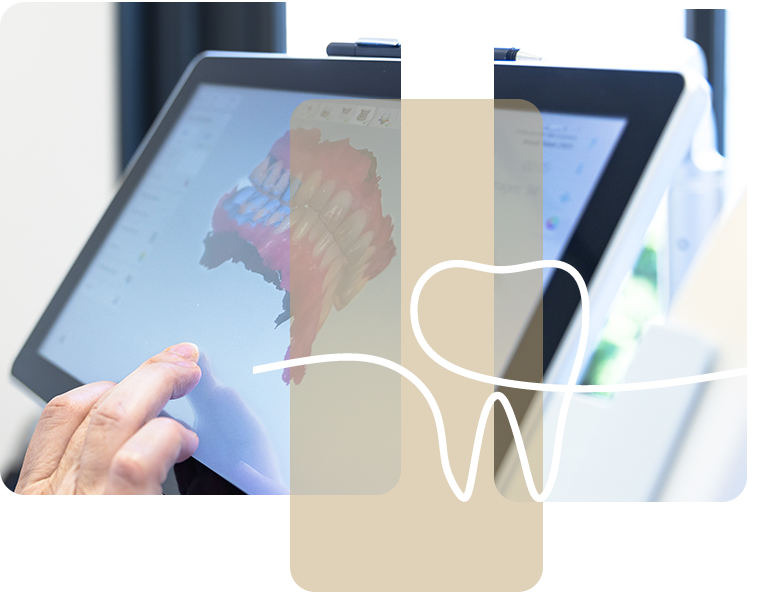An orthodontist sets your teeth straight in your mouth. The orthodontist uses braces and with these, pressure is put on the crooked teeth. As a result, they slowly straighten up. This works with adults and children. In children, even the direction of growth can be influenced so that, for example, an overbite is resolved.
Types of braces

Activator:
An activator is an appliance consisting of upper and lower braces, which are interconnected. It is used to stimulate mandibular growth in cases where the growth of the lower jaw is stunted compared to that of the upper jaw. This difference in growth can be recognised by an (excessive) overbite. When worn correctly, the activator ensures your jaws will fit together better and you will be able to use your mouth, teeth and jaws better by reducing the overbite.
Headgear:
Headgear, also called external braces, consists of an inner and an outer arch. The inner arch slides into tubes in your mouth, which are in turn attached to thin metal brackets on your upper molars. The arch exits your mouth at the corners and runs along your cheeks to the back of your head. It is fastened to either a band in your neck or a cap on your head. In certain cases, headgear can be used in combination with other appliances.
Headgear is generally used to create more space for the permanent teeth. Usually, you will move on to other braces once this has been established. Wearing headgear generally results in little inconvenience, even when sleeping. This is independent of your sleep position. It will take a few nights to get used to the sensation, during which you might wake up a few times. However, this will pass if you persevere. In the mornings, your molars might be a little sensitive, which is a completely normal reaction. Headgear should not be worn when eating or doing sports or in other situations where it can inadvertently hit against something.
Experience tells us headgear must be worn at least 14 to 16 hours per day to bring good results. Failing to do so will cause the treatment to become unnecessary complex. In extreme cases, treatment may even fail or need to be stopped; at the very least, it will last considerably longer. For children attending primary school, it is usually easiest to wear headgear at night and during school hours. Children in secondary school mostly reach the desired number of hours by wearing headgear after school and at night.
Lipbumper:
A lip bumper is an appliance forcing the lower lip to put slight pressure on itself, which it then transfers to the molars in the lower jaw. This pressure is just enough to prevent the molars from moving forward and provides enough space for permanent teeth and molars in the lower jaw when these start replacing baby teeth. Lip bumpers are often used before all teeth are replaced and in combination with headgear.
Invisalign:
Treatment with invisible aligners (transparent “sleeves” that align the teeth) consists of a set of removable aligners that you replace with a new set every 7 – 10 days on average. In addition, attachments (type of glue balls) will be placed on a number of teeth to obtain the desired corrections in combination with the aligners. Each aligner is custom-made just for your teeth. Each time you click a new aligner over the teeth, your teeth will gradually shift -step by step, week by week- to the desired position. Sometimes it is necessary to add rubber bands yourself to correct the upper and lower teeth relative to each other.
Wear the aligner full-time. Always take the aligner off while eating and drinking with the exception of drinking cold, non-carbonated water.
It can be difficult at first with talking, but by talking a lot you will get used to it faster.
Clean the aligner thoroughly at least twice daily with a toothbrush and cold water. Do not use hot water.
Make sure your teeth are thoroughly clean after eating/drinking before placing the aligner back in the mouth.
After the first set of aligners, a refinement is usually necessary for the finishing touch. This involves a new scan, slides and an X-ray. Thus, depending on the adjustments still needed, additional aligners will follow. It takes a few weeks before we have the new aligners in as time goes into shipping and requesting the new aligners. During that time, we recommend that you wear the aligners in the evening and at night to ensure that the teeth remain in the same position as during the scan for refinement.

Herbst appliance:
Herbst braces stimulate the forward growth of the lower jaw, moving the molars in the upper jaw backward and the teeth of the lower jaw forward. This reduces the overbite and ensures that the molars of the lower and upper jaw fit together properly. For an Herbst, 4 molars in the upper and lower jaws are fitted with rings, to which a kind of locomotive rod is attached. The advantage of the Herbst bracket is that it is internal and cannot be removed.
For good results, the braces must remain in the mouth between 9 and 12 months. Because the retainer is fixed in the mouth and thus works 24 hours a day, the Herbst is a very effective retainer. Also, the brace is little visible and speaking with it is easy. Often these braces are followed up with fixed braces.
With the Herbst brace, you can talk, eat and drink as usual. Do be careful when eating hard and tough foods.
Hyrax:
A hyrax is used if the upper jaw is too narrow in comparison to the lower jaw. A hyrax consists of metal braces with a screw in the middle, placed along the palate and attached to the back molars with rings The screw can be turned with a special key to increase tension on the braces, which thereby widen the upper jaw.. This puts tension on the braces, widening the upper jaw.
Palatal bar
A palatal bar is a thick wire running along the palate. It is attached to the inside of the back molars, thereby connecting and applying a twisting or expanding force to them. The palatal bar is often only used for a few months, during which it stays in the mouth. As you are unable to remove it yourself, you will be wearing it whilst eating, drinking, talking and brushing your teeth. This might cause some discomfort, but most people get used to the feeling within a few days In the beginning, you will feel pressure to your molars, which will be quite sensitive during the first week. As soon as the molars loosen up and start moving a bit, this sensitivity often disappears.
Permanent braces
When placing permanent braces, metal brackets will be glued to each tooth usually combined with metal rings around the molars. . A wire running through the brackets and rings causes the teeth to slowly start moving. To get this result, the wire applies pressure to the teeth and molars, which can therefore be a little sensitive, especially during the first few days.
Permanent braces have been the subject of many recent developments, he Incognito system being one of them. When using this system, the brackets are placed on the inside of the teeth and molars, which is a great way to correct the position of your teeth in a more subtle way. These are the only truly invisible braces, as it is absolutely impossible to see the brackets from outside the mouth.
At the end of the treatment, the braces are removed. All the brackets and rings are taken out of the mouth and all the glue is removed, signalling the end of the treatment with fixed appliances. However, this does not mean no further action is required. During the treatment, the position of your teeth and jaws have been corrected and a desired result has been achieved. To ensure this does not go to waste, a retention period is applied. Teeth need a little while to stabilise in their new position, whereas their surroundings (tongue, cheeks, lips) need to adjust to the new situation.. As time goes by, teeth are less likely to move back to their original position. However, teeth and jaws changing position can also happen to people who have not undergone orthodontic treatment. Teeth and molars will never stop moving! It is therefore essential that the braces supplied in the retention period are worn as advised.
There are two types of retainers: removable retainers or splints.
Removable retainer
Removable retainers are made of a clear plastic plate with wires and are placed against the palate. It should be worn day and night during the first month, after which evenings and nights usually suffice. The less pressure you feel when putting on your retainer, the shorter you need to wear it. However, do try to wear it overnight for as long as possible.Should your teeth start moving back because you fail to wear your retainer enough, a simple correction using this appliance is impossible.
Splints
Splints are glued to the inside of your front teeth. They are best left as long as possible, at least five to ten years but even no longer if they do not cause any problems. It is difficult to clean the teeth underneath the splints, so careful cleaning with dental floss and thin toothpicks is important. In the end, it is up to you to decide how long you want to wear your retainer. Should problems occur, contact the practice as soon as possible.





